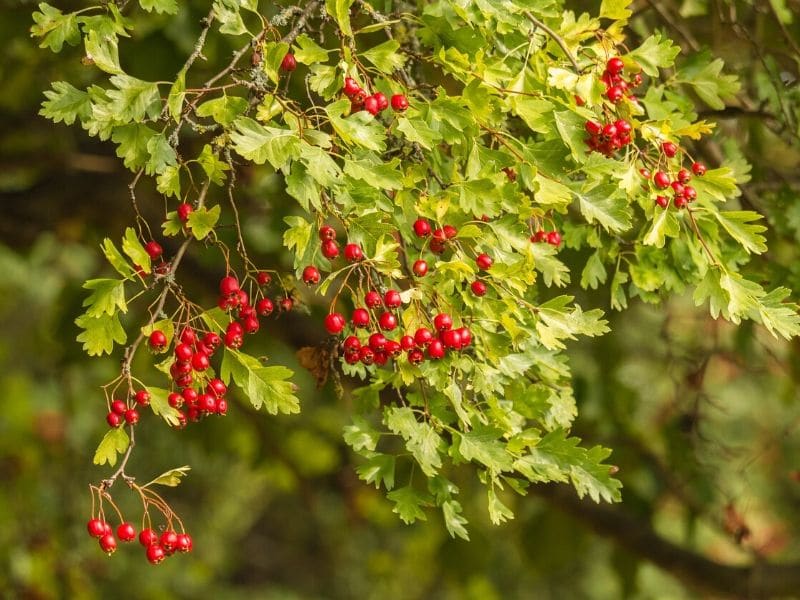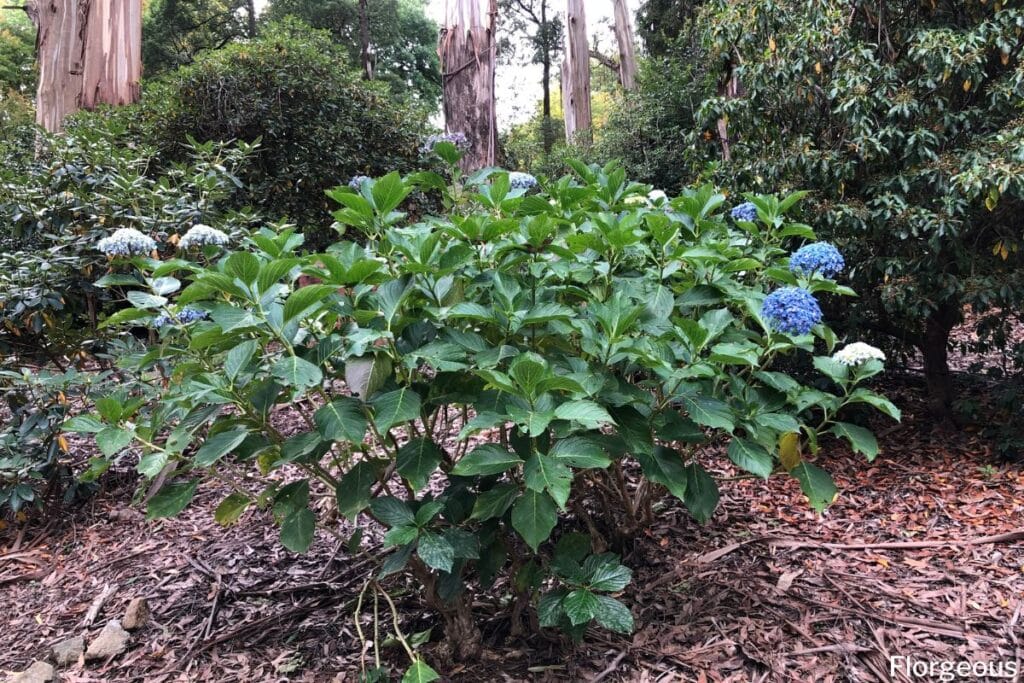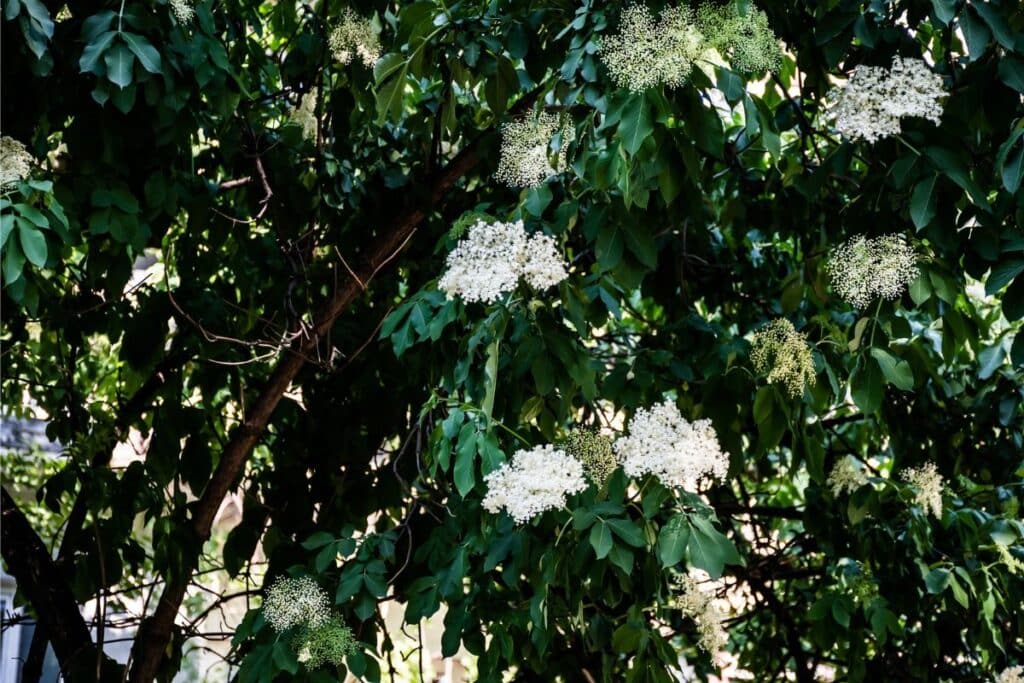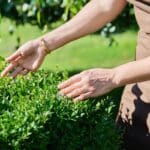Elderberry plants (Sambucus), also known as Black elder, European elderberry, or European elder, are beautiful small trees or shrubs that can add a lot of interest to your garden with their showy white flowers or interesting small berries.
These bushy plants can be paired with a variety of companion plants that can enhance the beauty of the shrubs or help repel pests. They will flourish next to companion plants like trees, shrubs, different berry shrubs, flowers, and herbs and they can even be used in veggie gardens.
In this guide, we are going to take a look at the top elderberry companion plants to grow next to your shrubs if you want a healthy and vibrant garden.
What to Plant with Elderberries
While you are busy math-making with elderberries, it is always best to first consider their growing conditions so you can find companion plants that will thrive in these same conditions.
Elderberry bushes are quite versatile because you can grow elderberries in full sun to full shade. This flexible nature makes elderberry shrubs ideal companions for short-shade-loving plants or taller trees.
These shrubs do prefer slightly acidic soil and should be grown in well-drained soil. You will also need to water them frequently because they prefer moist soil with lots of organic matter.
For companion planting, you should also consider the type of elderberry you have. There are many different varieties like the black lace elder (Sambucus nigra), red elderberry (Sambucus racemosa), and the common elderberry (Sambucus canadensis).
These different varieties can look quite different since some have black foliage, some have dark green foliage, some have blackberries, and others have red berries.
Let’s take a closer look at other plants that grow well with elderberries. You can grow the following companions with black lace elderberry, lemony lace elderberry, black tower elderberry, instant karma elderberry, and other cultivars.
Trees

Because elderberries grow well in the shade, you can easily plant them underneath trees. These shrubs are very useful for filling up shade gardens and you successfully grow them underneath a wide range of tree species.
Elderberries have shallow roots and as such, won’t interfere with the roots of most trees but it is best not to grow with trees that also have a shallow root system or they can start competing for space.
Because these plants prefer moist conditions, you should also be careful to establish them underneath elderberry companion trees that also require lots of moisture.
You can grow these large shrubs underneath a variety of tree species like a white pine tree (Pinus strobus), quacking aspen trees (Populus tremuloides), or cherry trees (Prunus).
You can even plant elderberries next to walnuts since they are some of the few plants that can tolerate the juglones that walnuts produce.
Flowering Plants

If you want to add more color to your garden or want to attract pollinators so you can boost your berry production then you should try to include lots of flowering plants in your garden. Flowering plants will lure all sorts of beneficial insects like bees and butterflies.
If you are growing flowers underneath the elderberry shrubs then you should select flowers that grow well in shade areas. Shade-loving perennials like hydrangeas, impatiens, astilbes, or violas will grow very well in the well-drained soil, shade, and moist conditions that the elderberry plant provides.
If your shrubs are positioned in full sun then you can select elderberry companions that can tolerate lots of direct sun and warmth.
Flowers like bee balm, phlox, nasturtiums, and forget-me-nots are good companion plants for elderberry in sunny locations because these plants also love moist soil.
Vegetable Garden
Elderberries are great shrubs to use around a vegetable garden. These shrubs will attract pollinators that can increase your vegetable yields and the hardy shrubs will look rather stunning as a hedge or border around your vegetable garden.
You can plant elderberries all around your veggies and include any type of vegetables in the center of your garden. Vegetables like squash, cucumbers, pumpkins, eggplants, watermelons, and muskmelons will all benefit from the pollinators that elderberry plants attract.
Just be careful to leave plenty of room between your vegetables and elderberry plants. Vegetables need plenty of direct sun to flourish and won’t develop well if the elderberry bushes cast too much shade. The shallow root system of elderberry plants can also deprive vegetables of nutrients if they are positioned too closely.
Other Berry Shrubs
You can certainly consider adding other berry shrubs when you are growing elderberries. This is ideal for gardeners who want to provide food for animal species like birds and squirrels.
Blueberries, winterberries, brambles, or currants are all terrific for elderberry companion planting. These shrubs will create lots of food for animal life and they are great for creating striking mixed borders or mixed hedges with lots of interest when the berries begin to ripen.
When you install elderberry companions in mixed borders or hedges, you should be careful to leave plenty of room for these plants to grow and expand.
If the garden is too full, some of these plants might not get enough direct sun and won’t provide food. It is also best to position taller varieties like elderberries in the back with shorter varieties like blueberries in the front.
Herbs
It’s a terrific idea to plant herbs with elderberry shrubs because they can help repel pests that often plague or feed on these berry shrubs. The herb shrubs will also act as a weed barrier and ground cover to keep the soil around your berries cool and moist for longer.
Herb varieties like mint, basil, chives, and rosemary are known for their pest-repelling abilities and are a definite must if you are growing elderberry plants around vegetables. Some herb varieties like borage and sage will also add lots of color to your garden during their bloom season.
When you are pairing herbs with elderberries, it is usually best to place the shorter herbs in the front with your tall shrubs in the back. You should also avoid placing herbs too close to your elderberry bush because herbs need plenty of direct sunlight to flourish.
What NOT to Plant with Elderberries
Elderberry plants are very easy to grow and they flourish in various conditions. Because of their flexible nature, they can be grown with a variety of other plants. Not all plants will, however, grow well right next to an elderberry bush.
Some flowers like lavender are likely to develop root rot if they are placed near elderberries because these flowers prefer dry soil.
You should also avoid planting elderberries next to nutrient-dependent vegetables like cabbages because elderberries require lots of nutrients and they have a shallow root system that is going to deprive these plants of nutrients.
Short sun-loving plant species also won’t develop too well right next to, or underneath a tall elderberry bush. These bushes are quite dense and might affect the growth of these sun-dependent plants.
It is also best to avoid trees with shallow roots like maple trees because the plants could start competing for nutrients and space.
Landscaping Ideas for Elderberry and Companions
Now that you know more about suitable elderberry plant companions, it is time to start discussing some creative ways to use these plants and their companions in your garden.
Let’s take a look at some creative ways to mix and match these plants for a striking garden.
Mix Contrasting Colors
If you want to add more contrast to your garden then you should consider combining black foliage plants like black lace elderberry with a contrasting plant like sage with its silvery leaves.
The black beauty will also look striking if you grow it next to other elderberries with contrasting leaf color.
Use as Mixed Borders
Elderberries and other berry shrubs will look rather charming if you use them as a mixed border around your property. These living borders are great for concealing unsightly areas in a garden or they can be very functional as privacy screens.
Use as Background Plants
You can also use your elderberry shrub as a background plant behind other beautiful ornamental plant species. The showy white flowers can add lots of beauty to your garden and will complement any flowers you grow in front of these backgrounds.
FAQs
Can I plant elderberries next to blackberries?
Yes, planting elderberries next to blackberries is generally compatible as they have similar cultural requirements. Both are hardy shrubs that thrive in well-draining soil and full sunlight, making them suitable companions in the garden.
Does elderberry have invasive roots?
Elderberries (Sambucus spp.) are known for having a vigorous root system, but they are not considered excessively invasive. However, it’s advisable to give them sufficient space and plant them away from structures or other plants that may be sensitive to root competition.
Do elderberries need to be planted in pairs?
No, elderberries do not necessarily need to be planted in pairs for pollination. While having multiple plants can enhance berry production, many elderberry varieties are self-pollinating, meaning a single plant can produce fruit on its own.
Final Thoughts
Elderberry plants are great shrubs to grow in your garden if you want something flexible and striking. These shrubs look especially charming if you plant them underneath trees like cherry trees or walnut trees. You can also mix them with other berries or flowering shrubs like blueberries, gooseberries, and many others. The bushy plants are good companions to include with vegetables and planting herbs like sage, catmint or chives can help these shrubs flourish.
We hope that our guide offered some helpful tips on the best way to combine elderberries with other plants. We are certain that your garden bed will look rather stunning with any of these combinations.
See more:
*image by AdrianaSulugiuc/depositphotos







